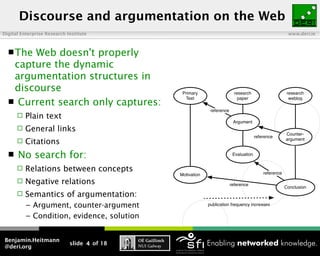Representing discourse and argumentation as an application of Web Science
- 1. Digital Enterprise Research Institute www.deri.ie Representing discourse and argumentation as an application of Web Science Benjamin Heitmann, Dr. Conor Hayes Digital Resources for the Humanities and Arts Conference 2009 Copyright 2009 Digital Enterprise Research Institute. All rights reserved. Chapter
- 2. Introduction Digital Enterprise Research Institute www.deri.ie The Web mirrors most areas of today’s society (e.g.: entertainment, science and humanities) Current Web does not capture structure of critique, argumentation, interpretation Representing types and granularity of discourse and links is necessary DERI has 3 approaches to discourse representation Foundation: Web Science as an interdisciplinary approach to understanding and engineering the Web (started by Tim Berners-Lee) Benjamin.Heitmann slide 2 of 18 @deri.org
- 3. Outline Digital Enterprise Research Institute www.deri.ie Motivation: Knowledge representation techniques to enable more sophisticated searching and querying of discourse on the Web Introducing Web Science: an interdisciplinary approach to understanding the Web and its evolution Applying the Web Science method: three approaches for discourse representation Benjamin.Heitmann slide 3 of 18 @deri.org
- 4. Discourse and argumentation on the Web Digital Enterprise Research Institute www.deri.ie TheWeb doesn't properly capture the dynamic argumentation structures in discourse Primary research research Current search only captures: Text paper weblog reference Plain text Argument General links Counter- reference Citations argument No search for: Evaluation Relations between concepts reference Motivation Negative relations reference Conclusion Semantics of argumentation: – Argument, counter-argument publication frequency increases – Condition, evidence, solution Benjamin.Heitmann slide 4 of 18 @deri.org
- 5. Representing the structure of discourse Digital Enterprise Research Institute www.deri.ie Knowledge on the Web is not sufficiently connected No standard vocabularies for representation of discourse structure and link granularity Queries are un-intuitive and imprecise, no negative queries Links are un-typed, and only on document level No semantics of relationships Source: “Clickstream Data Yields High-Resolution Maps of Science,” Bollen, Van de Sompel, et al. PLoS ONE (2009) Benjamin.Heitmann slide 5 of 18 @deri.org
- 6. Insights from Web Science Digital Enterprise Research Institute www.deri.ie The “Web Science” idea was started by Tim Berners- Lee and researchers from Southampton (see sources) 1. Understanding the current Web requires an interdisciplinary and holistic view of the Web on a whole 2. On the Web, engineering and social factors will influence each other and create a feedback loop 3. Properties of the Web are based on emergent behaviour, which can be empirically measured Benjamin.Heitmann slide 6 of 18 @deri.org
- 7. A Systems-level view of the Web Digital Enterprise Research Institute www.deri.ie Classical reductionist approach does not work Understand- ing the current Web requires an inter- disciplinary view No delegation of research on one area to only one discipline © Web Science Research Initiative Benjamin.Heitmann slide 7 of 18 @deri.org
- 8. The Web Science Process Model Digital Enterprise Research Institute www.deri.ie On the Web, engineering and © Lawrence Lessig social factors will influence each other. Increase in complexity: result is transition from micro to macro effects Source: CACM Web Science Article Example: Evolution of Blogs Independent blogs: Track-backs, Comments, Spam Twitter: Microblogging, HashTags, Location aware Facebook: Lifestreaming, Privacy Benjamin.Heitmann slide 8 of 18 @deri.org
- 9. Emergent properties of the Web Digital Enterprise Research Institute www.deri.ie Empirical properties: In- and out-degree distribution of links Power laws Growth: 7 million new pages Source: “Graph structure in the Web”, Broder, a day in 2005 Kumar et al. Emergent patterns: Popular tags (folksonomies) on Web 2.0 sites © Clay Shirky Emerging of an editorial elite on Wikipedia Benjamin.Heitmann slide 9 of 18 @deri.org
- 10. Approaches for discourse representation Digital Enterprise Research Institute www.deri.ie The Web Science method and discourse representation: Interdisciplinary: theoretical foundation is based on Speech act theory and Language Game theory Expect a feedback loop between Semantic Web solutions and usage patterns of community Empirical approach: CORAAL: use knowledge extraction and integration on large data collections Normative (engineering) approaches: – SIOC Argumentation vocabulary: light-weight and community-driven – SALT: annotation of argumentation semantics Benjamin.Heitmann slide 10 of 18 @deri.org
- 11. CORAAL: empirical discourse analysis Digital Enterprise Research Institute www.deri.ie Knowledge extraction and integration Pattern discovery Use emergent patterns in large document collections Go beyond text based search: Answer negative queries Detect relations between concepts UsesNatural Language Processing No mark-up required Benjamin.Heitmann slide 11 of 18 @deri.org
- 12. CORAAL screen shot of results for the search term “breast cancer”
- 13. SIOC argumentation vocabulary Digital Enterprise Research Institute www.deri.ie Light-weight and informal Express structure of argumentation: Who is participating? Where are the elements of the discourse distributed? How are the elements connected? Extensibility enables community involvement Benjamin.Heitmann slide 13 of 18 @deri.org
- 15. SALT: Semantically Annotated LaTex Digital Enterprise Research Institute www.deri.ie Enables mark-up of documents for claim identification Exposes the semantics of the argumentation. Examples: Claims, explanations Rhetorical structure (abstract, contribution, evaluation) Argument, counter-argument Creates PDF with content and structure Benjamin.Heitmann slide 15 of 18 @deri.org
- 16. discourse representation in SALT
- 17. Summary Digital Enterprise Research Institute www.deri.ie Representing discourse allows intuitive querying and searching of the argumentation semantics The Web Science method provides insights to representing discourse: Use interdisciplinary approach; Expect feedback loop between technical and social factors; Detect emergent properties and patterns Three approaches at DERI for representing discourse: CORAAL: empirical, knowledge extraction+integration SIOC argumentation vocabulary: light weight, bottom up SALT: annotate argumentation semantics in publications Benjamin.Heitmann slide 17 of 18 @deri.org
- 18. Questions? and Sources! Digital Enterprise Research Institute www.deri.ie These slides: http://www.slideshare.net/metaman Web Science:“Web science: an interdisciplinary approach to understanding the web”, Hendler, Shadboldt, Hall, Berners-Lee, Weitzner, Communications of the ACM (2008) CORAAL: demo at http://coraal.deri.ie:8080/coraal “CORAAL-Dive into publications, Bathe in the Knowledge,” Novacek, Groza, et al., Journal of Web Semantics, Elsevier (2009) SIOC argumentation vocabulary:“Expressing Argumentative Discussions in Social Media Sites”, Lange, Bojars, et al., Workshop on Social Data on the Web at the International Semantic Web Conference (2008) SALT:“SALT-Semantically Annotated LaTex for Scientific Publications,” Groza, Handschuh, et al., European Semantic Web Conference (2007) Benjamin.Heitmann slide 18 of 18 @deri.org


















